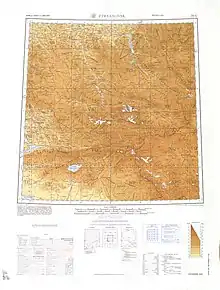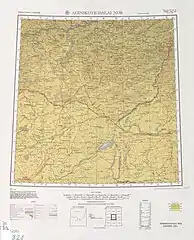China–Mongolia border
The China–Mongolia border is the international border between China and Mongolia. It runs from west to east between the two tripoints with Russia for 4,630 km (2,880 mi), with most of the boundary area lying in the Gobi Desert.[1]



Description
The border starts in the west at the western tripoint with Russia in the Altai Mountains, located just 100 kilometres (62 miles) east of the China-Kazakhstan-Russia tripoint. From there it runs overland in a generally south-eastwards direction, with straight line sections predominant in the Gobi Desert section, down to the southernmost point of Mongolia just north of the 40°30 line of latitude. From there it proceeds overland in a north-eastwards direction, over to the Greater Khingan mountains near Mongolia's easternmost point. From there the border veers to the north-west and then west, utilising the Khalkhyn Gol river for a stretch before running through Buir Lake, and then turning sharply to the north-east up to the eastern Russian tripoint.
History
.jpg.webp)
Russian had expanded into far into Siberia during the course of the 17th century, bringing it into conflict with Qing China, which at that time maintained a tenuous rule over Mongolia (called "Outer Mongolia", to differentiate it from Inner Mongolia which was under more effective Chinese control).[2] Much of the line of the today's Mongolia–Russia border line was set by the Treaty of Kyakhta (1727) between Russia and China.[2][3][4]
With China engulfed in chaos following the collapse of the Qing dynasty in 1911, Mongolian nationalists seized the opportunity to declared Outer Mongolia independent, with the support of Russia.[4] In 1915 the Second Treaty of Kyakhta was signed, by which Russia acknowledged formal Chinese suzerainty over Mongolia, albeit with Russia maintaining significant influence, leaving the country in effect as a semi-autonomous condominium.[4] Following the Russian Revolution in 1917 China invaded Mongolia in an attempt to re-assert full control, however they were ultimately repulsed by Mongol and Soviet Russian forces, with Mongolia declaring independence in 1921.[4] China's refusal to recognise the country's independence meant that no formal border delimitation was conducted, though the remoteness and inhospitable, scarcely populated boundary terrain meant that this was in practice not a pressing issue.[2] However, following Japan's invasion of Manchuria in 1931 and disputes over the Nomonhan region, Mongolia and the Japanese puppet-state of Manchukuo delimited a small section of their eastern frontier in 1935–39 in the vicinity of Buir Lake, though Japan was defeated in the Second World War leaving the status of this agreement in doubt.[2][4]
Following a plebiscite, and assurances from the USSR that they would not interfere in China's restive Xinjiang province, China agreed to recognise Mongolia's independence in 1946.[2] Disputes soon arose over the border, notably over the gold-rich Baytik Mountains in 1947, and further work on boundary delimitation was hampered by the Chinese Civil War.[2][4] With the Communists in power in China from 1949, relations with Mongolia steadily improved, and the two countries signed a treaty on 26 December 1962 delimiting their common frontier.[2][4] A full border demarcation then occurred from 1963 to 1964 and a final treaty with a detailed set of maps agreed upon on 30 June 1964.[4][2] Though relations have at times been tense since then, notably during the 1960s Sino-Soviet split in which Mongolia sided with the USSR, the border has remained where it is and relations between the two states have remained generally cordial.[4]
Sex trafficking
Mongolian and Chinese women and girls are sex trafficked across the border.[5] There are large mines and other heavy industrial operations located in the border region containing large workforces of isolated men; these sites, including the ones in Tavan Tolgoi coal deposits, have been a focal point for prostitution and sex trafficking.[6]
Border crossings
There are several official border crossings:[7]
- Bulgan – Takashiken
- Bichigt Zuun-Khatavch
- Zamin Uud – Erlian
- Sheveekhuren – Sekhee
- Sumber – Arxa/Aershan
Settlements near the border
Mongolia
- Jargalant
- Mandal Sum
- Enger Hulasa
- Qagan Obo
- Ulaan-Uul
- Sentarbanshan
- Hawahaharo
- Halhin Gol
- Mongolryba
- Shabarta
Historical maps
Historical maps of the border from west to east from the International Map of the World, middle 20th century (partial):
See also
References
- "MONGOLIA". Retrieved 31 January 2020.
China 4630 km
- "International Boundary Study No. 173 - China-Mongolia Boundary" (PDF). US Department of State. 14 August 1984. Retrieved 15 September 2020.
- "Mongolia". US DOS. Retrieved 15 September 2020.
- Dashtseren, Dashdavaa (September 2006). "BORDER PROTECTION AND NATIONAL SECURITY OF MONGOLIA" (PDF). NAVAL POSTGRADUATE SCHOOL MONTEREY, CALIFORNIA. Retrieved 15 September 2020.
- "Stolen from Mongolia for sex". PRI. July 22, 2009.
- "Mongolia's prostitution zones, where women trade sex for fuel in sub-zero temperatures". The Telegraph. February 19, 2019.
- "Mongolia Border Crossings". Caravanistan. Retrieved 15 September 2020.
| Wikimedia Commons has media related to China-Mongolia border. |







